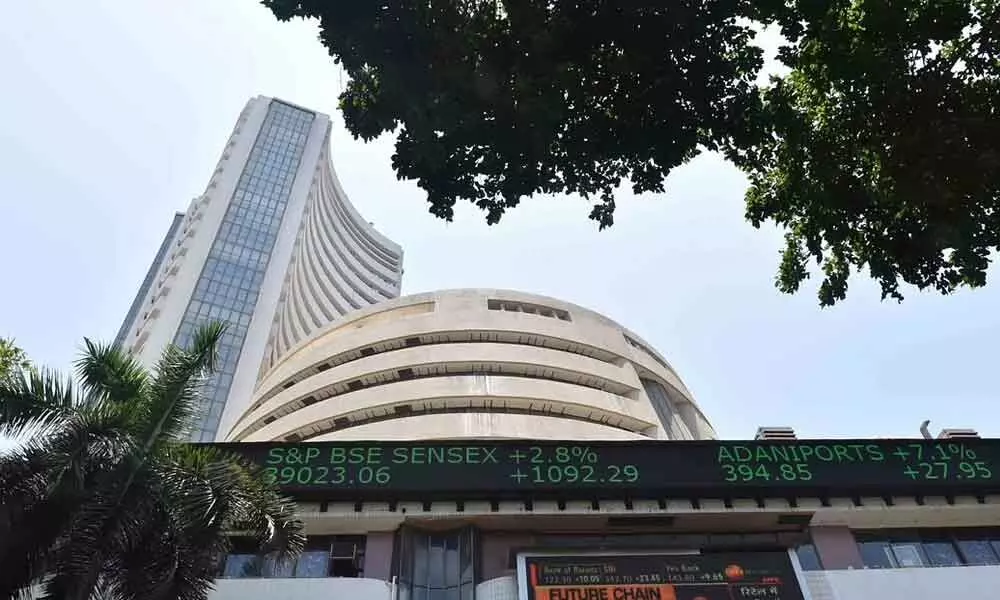Live
- Nizamabad MP Dharmapuri Arvind and Jagtial MLA Dr. Sanjay Kumar Meet CM Revanth Reddy
- Hyderabad CP CV Anand Issues Stern Warning to Bouncers
- MP Laxman Criticizes Police Conduct, Calls for Support for Victims' Families
- Fire Breaks Out in Kachiguda-Chennai Egmore Express, Passengers Evacuated Safely
- CM Revanth Reddy Condemns Attacks on Film Personalities' Homes, Calls for Strict Action
- Victory Venkatesh and Nandamuri Balakrishna to Set Screens on Fire with Unstoppable Season 4
- Over 71.81 crore Ayushman Bharat Health Account numbers generated: Centre
- In special gesture, Kuwait's Prime Minister sees-off PM Modi at airport after conclusion of historic visit
- Veer crowned PGTI Ranking champion, Shaurya wins emerging player honour
- Sr National Badminton: Unseeded Rounak Chauhan, Adarshini Shri reach singles semis
Just In
Positive macro data may further push indices up


With India’s growth indicators showing good signs of revival and crude oil prices staying lower, it is expected that market will continue to remain bullish and possibly touch lifetime highs in next few weeks
After touching multi-month highs on the back of renewed buying by foreign institutional investors (FIIs); surprised by the MSCI tweak on HDFC twins, US Fed rate hike and weak global cues; the domestic stock markets closed on a flat note during the week ended May 5. With India’s growth indicators showing good signs of revival and crude oil prices staying lower, it is expected that market will continue to remain bullish and possibly touch lifetime highs in next few weeks.
NSE Nifty rose just 0.02 percent during the week to close at 18,069 points, while BSE Sensex fell 0.10 per cent. Better than expected earnings announcements brought cheer to the midcap space. Both the Mid-cap and Small-cap indices advanced 1.1 percent and 0.6 percent, respectively. FIIs bought shares worth Rs5,527 crore till date in May. It is pertinent to observe that FIIs have made purchases worth Rs1,997.70 in March and Rs5,711.80 in April.
Favourable domestic macroeconomic data like manufacturing PMI and the GST collections in April helped revive the FII sentiment. IMD forecast a normal monsoon for 2023, with rains estimated at 96 per cent of the long-term average, but also observed that El Niño conditions are likely to develop during the monsoon season.
“El Niño conditions create drought conditions and lower agricultural output; leading to elevated prices, geopolitical developments and global financial stability. If an El Niño does occur later in the year, as even meteorologists elsewhere in the world predict, it could end the run of good monsoons in the last four years, though this is not certain. However, India has had good monsoons even in El Niño years, and deficient rainfall in years when the El Niño was not prevalent. Oil prices fell for the third straight week after US Fed rate hike and on concerns that the US banking crisis will slow the economy and impact fuel demand.
Low crude prices are good news for India, as 80 per cent of its oil needs come from imports. Crude is also a key raw material for several industries like paint, tyre, pipe and aviation, which stand to benefit from the low prices. Experts expect crude oil will consolidate in the lower range after a recent steep fall in price.
Observers expect CPI inflation to moderate in April and forecast headline inflation at 4.8 percent year-on-year, down from 5.7 percent in March. The RBI’s preferred core inflation measure is also seen continuing to inch down, but at a slower pace than headline, falling to 5.3 per cent YoY in April from 5.7 per cent in March. The near-term direction of the market will be dictated by stock-specific action, macroeconomic indicators, international crude prices and global cues. Adopt Buy on Dips strategy, say old timers.
Listening Post: Finding Your Balance in a Topsy-Turvy Market. Taking calm, contrarian action in a crazy world is a great way to restore balance—not only to your portfolio, but to your frame of mind. The market wisdom that sounds the easiest can be the hardest to follow.
By late March, stocks had corrected sharply, while some assets like Gold have rallied. That would have left a sizable divergence from your 60/40 target. To get back to 60 per cent stocks and 40 per cent bonds, you could buy some stocks, sell some of the other assets or both. The debate over how and when to do that is endless. Some analysts advocate adjusting back to your targets annually; others say semi-annually, quarterly, monthly, even daily. Still others argue that you should rebalance only when your asset mix is at least 1% or 3% or 5% or 10% off your targets.
There’s no way to tell in advance which rebalancing method will turn out best, because the results depend on how much your assets fluctuate in the future and how different their returns will be. What’s more, the variations in historical results across rebalancing techniques are surprisingly small, and have found that the frequency and magnitude don’t make much of a difference.
With interest rates near new recent highs, many investors have asked me whether rebalancing out of stocks and into FDs makes sense. (Several stocks are up almost 10-20% in the past five weeks, so some who rebalanced into stocks in March are wondering whether they should now rebalance into FDs.). It makes sense to sort your assets into a few buckets: stocks, gold, high-quality FDs, cash, real estate, perhaps one or two for other. Set target ranges for each bucket. Once or twice a year, or whenever market moves push an asset at least five per cent above or below your target range, you should rebalance.
Quote of the week: An investment in knowledge pays the best interest — Benjamin Franklin
When it comes to investing, nothing will pay off more than educating yourself. Do the necessary research and analysis before making any investment decisions.

© 2024 Hyderabad Media House Limited/The Hans India. All rights reserved. Powered by hocalwire.com






